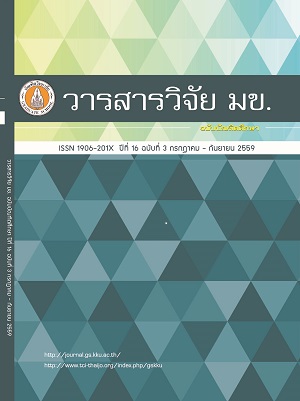การสุขาภิบาลอาหารและการจัดการสิ่งแวดล้อมของศูนย์อาหารและบริการ มหาวิทยาลัยแห่งหนึ่งในจังหวัดขอนแก่น (Food Sanitation and Environmental Management of Food and Service Center, University of Khon Kaen Province)
Keywords:
การสุขาภิบาลสิ่งแวดล้อม (Environmental sanitation), การสุขาภิบาลอาหาร (Food sanitation), การปนเปื้อนเชื้อแบคทีเรีย (Microbial contamination)Abstract
การศึกษานี้เป็นการวิจัยเชิงพรรณนาแบบตัดขวาง (Cross-sectional descriptive study) มีวัตถุประสงค์เพื่อศึกษาการปนเปื้อนจุลินทรีย์ในตัวอย่างอาหาร ภาชนะ และมือผู้สัมผัสอาหาร และประเมินการสุขาภิบาลอาหารและการจัดการสิ่งแวดล้อมของศูนย์อาหารและบริการในมหาวิทยาลัยแห่งหนึ่ง จำนวน 22 ร้าน ผลการศึกษาพบว่า การสุขาภิบาลอาหารพบการปนเปื้อนโคลิฟอร์มแบคทีเรียในมือผู้สัมผัสอาหาร ร้อยละ 72.73 Staphylococcus aureus มีการปนเปื้อน ร้อยละ 36.36 ของตัวอย่าง E.coli มีการปนเปื้อนในตัวอย่างอาหาร ร้อยละ 81.82 และ ไม่พบ Salmonella spp. ปนเปื้อนในตัวอย่างอาหารที่ตรวจวิเคราะห์ ในด้านการจัดการสิ่งแวดล้อมของศูนย์อาหารและบริการ ด้านห้องส้วมยังไม่ผ่านเกณฑ์ห้องส้วมสาธารณะ การจัดการมูลฝอยอินทรีย์และมูลฝอยทั่วไปใช้วิธีนำไปฝังกลบ ส่วนมูลฝอยรีไซเคิลใช้วิธีจัดประมูลรับซื้อมูลฝอย ส่วนการจัดการน้ำเสียพบว่าศูนย์อาหารและบริการไม่มีถังดักมัน น้ำเสียรวมบำบัดด้วยระบบแอกทิเวเต็ดสลัดจ์ อย่างไรก็ตามผลการศึกษาแสดงให้เห็นว่าการจัดการสุขาภิบาลสิ่งแวดล้อมยังไม่ถูกสุขลักษณะ ดังนั้นหน่วยงานที่เกี่ยวข้องควรดำเนินการกำกับดูแลควรให้ความรู้และการฝึกอบรมเกี่ยวกับปัญหาเหล่านี้ให้กับบุคคลที่เกี่ยวข้อง เพื่อให้ความมั่นใจแก่ผู้บริโภคและผู้มาใช้บริการ
This cross-sectional descriptive study was conducted to assess the food sanitation and environmental management of food and service center the of University campus in Khon Kaen province. Samples were collected from 22 food shops and studied for microbial contamination in the food, food utensils, and food handlers. The results showed that, overall, seventy two percent were contaminated by Coliform bacteria. Thirty six and eighty one percent of sample in food samples were contaminated by Staphylococcus aurous and E.coli, respectively, while Salmonella spp. were undetectable And environmental management of the toilets did not meet the criteria of public restroom. For solid waste management, recycle waste was separation and sold, while the rest was collected and transported to a landfill. Wastewater was treated by activated sludge system. However, grease trap was not installed to preliminary treated wastewater. Therefore, the responsible authorities should supervise, educate, and train about these issues to relevant personal to assure consumer confidence.


